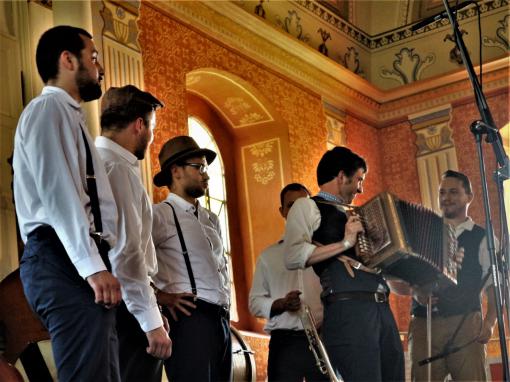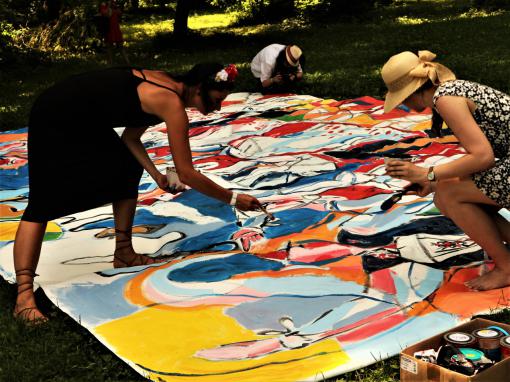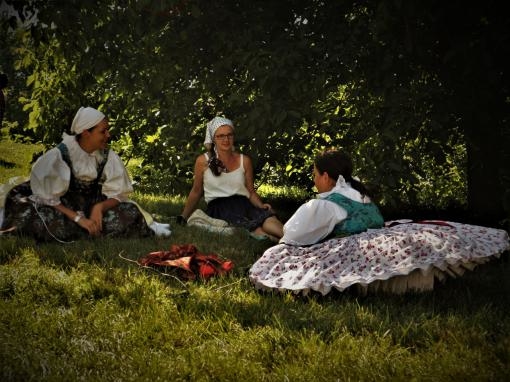Last weekend, the 74th Strážnice International Folklore Festival 2019 as well as the 37th Strážnice Children's Folklore Festival were held in the South Moravian Mecca of folklore. The biggest folklore festival in the Czech Republic enjoys great interest and it wasn't any different this year either, despite tropical temperatures, with tens of thousands of people coming back to Strážnice again.
One of the greatest attractions of the festival is the competition for the best dancer of the Slovakian verbuňk [recruit dance]. This programme underwent a major change last year. It was moved from the Garden amphitheatre to the Castle amphitheatre. This change was probably unavoidable and necessary because the capacity of the latter amphitheatre is considerably larger, and it was filled up last year as well this year. However, the competition lost some kind of its intimate, friendly character. The atmosphere grew into mass stadium-type chanting, moreover in the sets of hot concrete grandstands. However, this does not change anything in the quality of the dancers participating in the competition. This year was carried under the sign of the memory of the spiritual father of Strážnice recruiters Karel Pavlištík, who left us at the end of last year. As a dancer and ethnographer, he not only significantly contributed to the current form of the competition, but also to the inclusion of the dance on the UNESCO list. This year, the competition also went through a minor change. Recruits from the Brno region could also officially enter it for the first time. In their ranks, there always used to be a great deal of interest in this competition, but there was no category clearly reserved for this region. This year, it was represented by Martin Kšica on the basis of a spectators' poll. The winner of this year's competition was Martin Vašulka from Kyjov.

The programme, which was undoubtedly the most visited, was the concert of two professional ensembles – VUS Ondráš and SĽUK. It was actually a compensation for last year, when the same programme was cancelled due to persistent rain. This time the two ensembles met on the stage of the Castle amphitheatre and filled it up to the last place. The spectators' enormous acclaim was admirable, but sometimes there were a few bullies through the gates the crowd trying to get in a very rude way. However, those who managed to get to the auditorium were part of a great music and dance experience supported by the accumulation of great enthusiasm and energy in one place.
The programme composition has its own rules, so the audience was traditionally allowed to take part in the evening programme of foreign ensembles, a concert of the winners of the singing competition Zpěváček [Little Singer], or children's music bands.
From the evening programmes, I would like to highlight the Friday's show named Bez bab [No Ladies]. It featured male dance formations from Pilsen as far as Romania. The stars of the show were dancers from VUS Ondráš of the nineties, who still did not lose their grace and swing, the Briakovci Brothers, who, with a great and truthful accompaniment of Lubomír Graffe's dulcimer music band, performed podpolianské prekáračky, perhaps the most high-tempered dance of our Slovak neighbours. Mention should also be made of Wallachian odzemkáři, the male part of the Mladina ensemble from Pilsen or the harsh gorals from Oravan Senior Folklore Ensemble. They all took care of a great experience, eventually enjoyed both by "ladies and guys".

Goral folk art could also be admired in the subsequent programme entitled Ze života stromů [From the Life of Trees], which was a magical intersection of the world of nature and people. How the individual trees influenced folk culture, what healing and magical properties were attributed to them, and how this all was reflected in the songs of that particular region – the programme was trying to convey all this to the audience. The evening hour and dark shadows of trees in the Garden amphitheatre lend that all a unique atmosphere.
Not very frequented, but for me quite exceptional, are the programmes in the Museum of the Village Southeast Moravia. There were several programmes between barns and cottages of most of the Slovácko sub-regions: Přes ty vinohrady je tam pěkná cesta [There Is a Nice Path over the Vineyards], Písně pro nevěstu [Songs for the Bride] and Jaké si to uděláte, takové to budete mět [You Will Have It the Way You Do It]. I think the names of these songs reveal everything by themselves.
Of particular importance to me are those programmes that, in addition to the aesthetic function of the contemporary stage folklorism, also pursue educational goals. In the hands of masters, this can happen so naturally that the viewer does not even notice being educated or instructed. A programme, which fulfilled all this and moreover was held in the unusual premises of the Old Synagogue, was called Karpatské návraty [Carpathian Returns]. The insight into traditional musical forms and groups from the White Carpathians region was raw, lively and natural in the best sense of the word. It is very pleasing that the programme was held in a nice atmosphere for the audience, and at the same time it was appreciated by experts, who gave its author Peter Obuch the Laureate Prize of this year's Strážnice.
Man does not live only from music and dance, so I would also like to highlight this year's Jarmark chutí a vůní [Fair of Flavours and Fragrances] and the Zbojnická lúka [Bandits' Meadow]. These two relatively new venues quickly became a popular stop for visitors to the festival. The Fair of Flavours and Fragrances offers traditional regional delicacies and, in my opinion, could be extended to a larger area reserved for stalls. The Zbojnická lúka is a recently restored place in the heart of the castle park, where dance workshops, theatres or happenings for children and adults take place in the shade of massive trees.
Those who have not yet experienced the atmosphere of this folklore holiday should finally decide to come to Strážnice. Even though some may be dissuaded by its size and massiveness, it is still a unique experience not only for folklore lovers.
































No comment added yet..